-
How we help
- Does my software work?
- Does it work for all users?
- Global Growth Toolbox
- Industries
-
Platform
- Platform
- Integrations
- Browse all test types
- Add-on services
- Pricing
- Resources
What is Regression Testing? | Methods & Benefits
What is regression testing? What regression testing tools are available? How do you perform regression testing? We're here to answer all your burning questions in our ultimate guide.
Regression testing is among the most important parts of your overall testing suite and among the most well-known types of software tests. Here's our breakdown of the best practices, the failure categories, and how to get started with regression testing today.
What is regression testing?
Regression testing is a type of QA software testing that ensures changes or updates to an existing software product do not affect previously functioning features.
This type of testing may be necessary following various changes, including:
- Bug fixes
- Software enhancements
- Configuration adjustments, and
- Even the substitution of electronic components (hardware).
A regression test asks, "Does everything still work as expected?" A malfunction or bug in another part of the system caused by a new release is called a "regression," hence the term "regression testing." 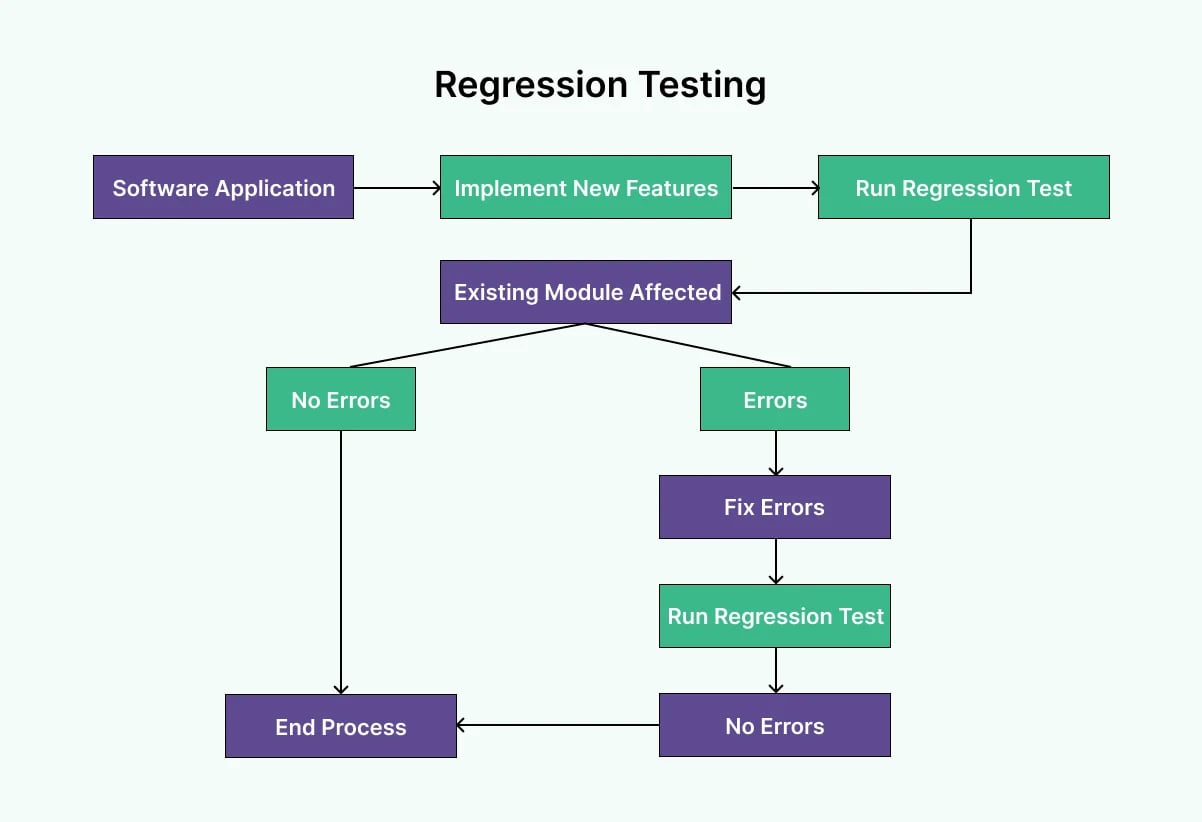
A dev team is generally expected to run a regression test suite at the end of a development sprint. Still, they can also perform regression testing during development as part of your CI/CD pipeline in an agile testing environment.
Regression testing encompasses a broad spectrum of testing methodologies, such as functional testing, performance testing, and security testing. Additionally, it involves examining integrations among different software components and validating data migration between systems.
Why should you perform regression testing?
Regression testing is indispensable within the testing framework as it detects whether code alterations or enhancements are introducing new defects or disrupting existing functional tests.
Even minor code modifications could potentially result in expensive errors without a regression testing procedure. Thus, upholding software quality is a systematic practice that prevents the reoccurrence of known issues and instills confidence in the software.
Example of regression testing
Let's take a web-based e-commerce platform as an example. Suppose the development team introduces an enhancement to the search functionality, allowing users to filter products by color. Here's how regression testing might be applied in this scenario:
- Product browsing: Despite the changes made to the search functionality, users should still be able to browse through product categories, view product details, and add items to their cart without any issues.
- Cart management: Regression testing ensures that users can seamlessly add, remove, and update items in their shopping carts even after the new search filter feature is introduced.
Checkout process: Verifying that customers can proceed through the checkout process smoothly, from entering shipping and billing information to completing the payment, is crucial. Regression testing ensures that this critical functionality remains intact.
User accounts: Testing the user account management system to confirm that users can still log in, update their profiles, and view order history without encountering any disruptions due to the changes made.
Mobile responsiveness: Regression testing might also include checking the platform's responsiveness across different devices and screen sizes to ensure that the new search filter feature has not caused layout or usability issues on mobile devices.
How is regression testing different from re-testing?
Retesting involves searching for a specific defect recently identified, possibly after it has been addressed. In contrast, regression testing entails a broader search for defects across the entire product following a new feature release.
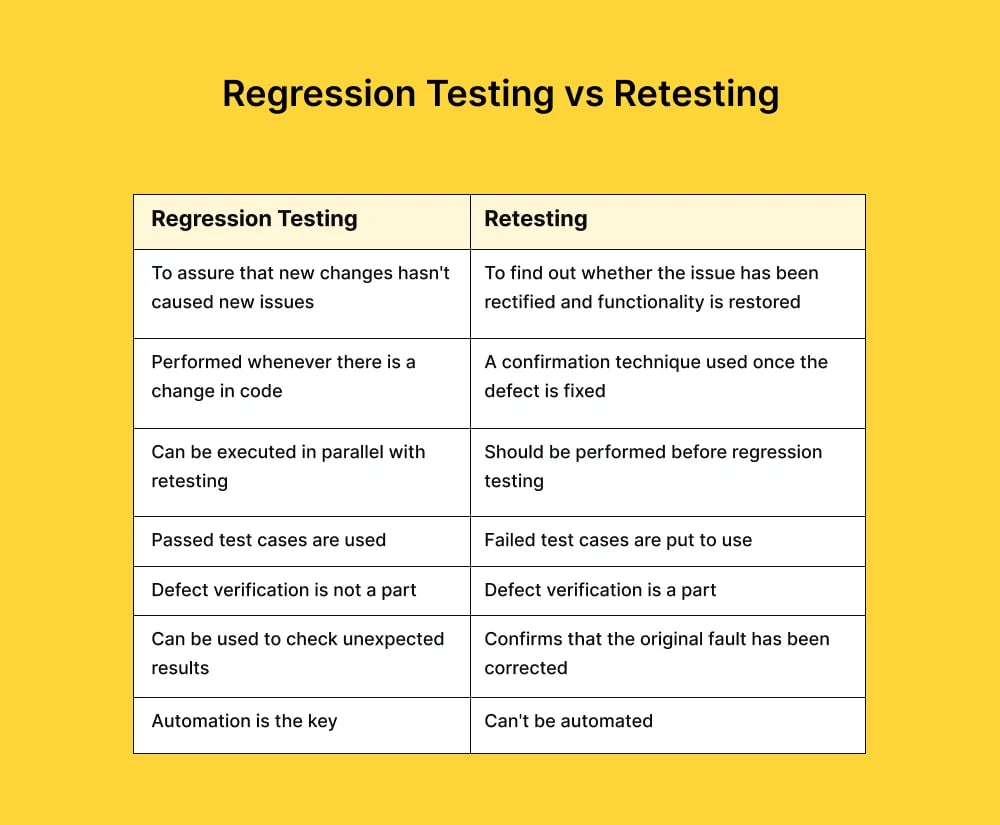
Types of Regression Testing
Although each test shares the common objective of uncovering bugs, flaws, and issues, they do so through diverse methodologies and application scenarios:
1. Retest-all regression testing
Retest-all regression testing is the most exhaustive type. Every test scenario is re-executed using all previous test cases to compare against previous testing outcomes. It is conducted when all existing tests on new code need to be rerun to uncover regressions.
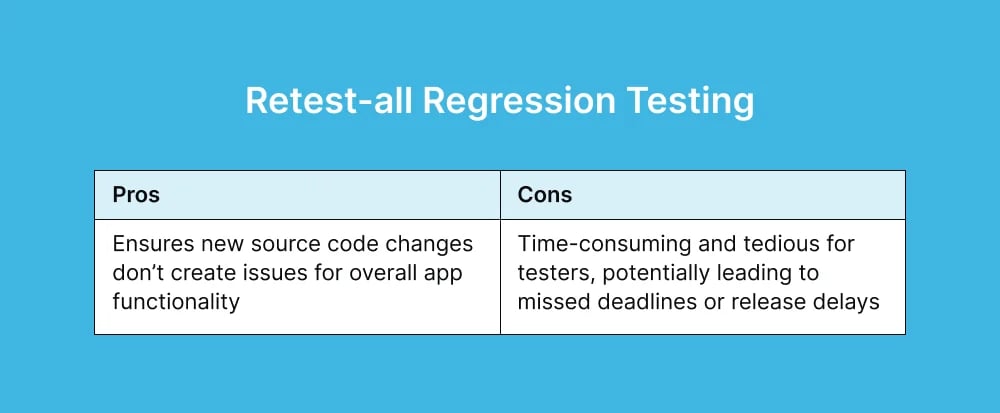
2. Corrective regression testing
Corrective testing is employed when the source code has not been altered or updated and the application's overall functionality needs to be tested.
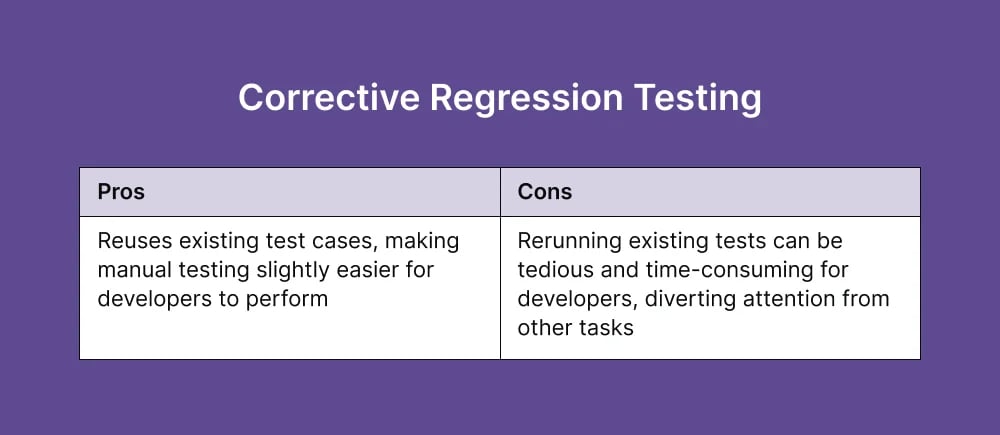
3. Selective regression testing
Selective regression testing assesses the influence of new code on existing code and evaluates the impact of both new and existing code elements. It integrates variables and functions into the application to assess outcomes without disrupting the process. This testing is conducted after new code additions.
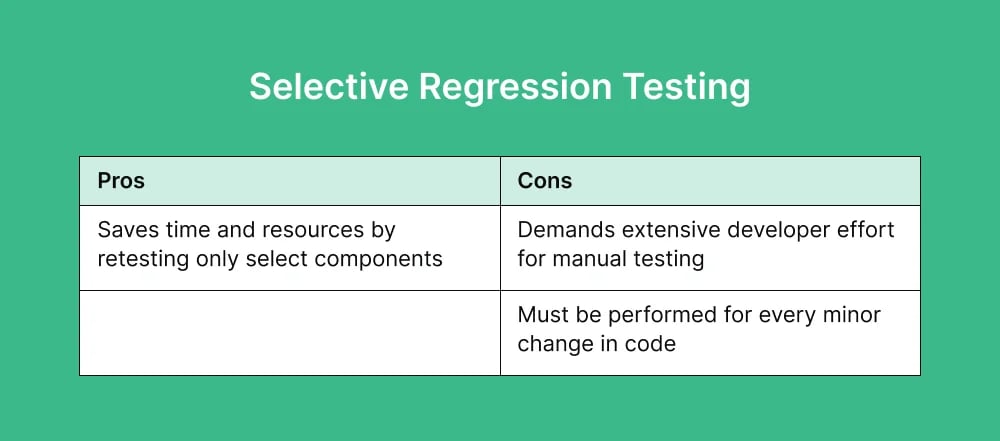
4. Progressive regression testing
Progressive regression testing safeguards existing features from compromise when transitioning to an updated or newer version of an application. It is executed when new test cases and specific changes in program specifications are designed.
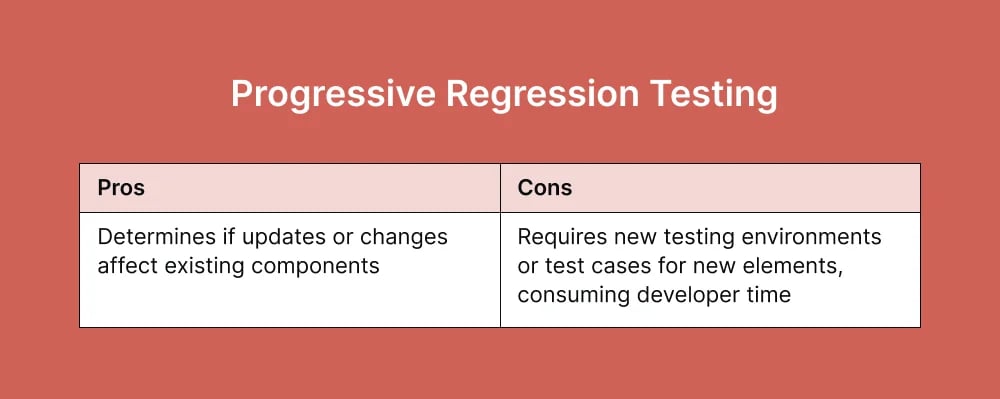
5. Progressive regression testing
When numerous changes have been implemented in the codebase, impacting the root code, complete regression testing is employed to uncover unexpected bugs. Typically conducted before launch, this testing method helps identify whether new changes affect the root code.
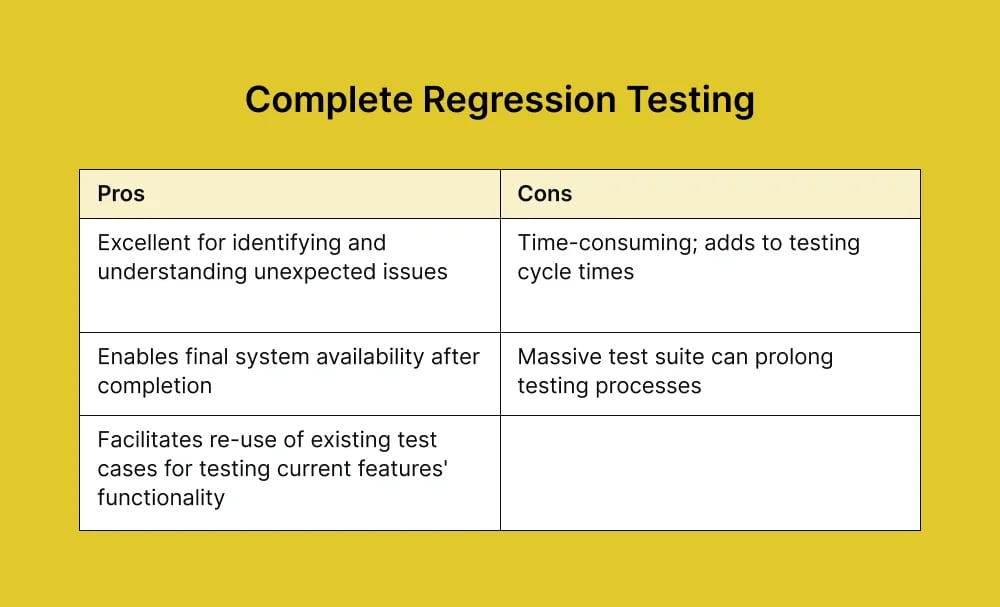
6. Partial regression testing
Partial regression testing verifies that a system functions correctly after integrating new code. It is conducted after adding new code to existing code, often after performing impact analysis.
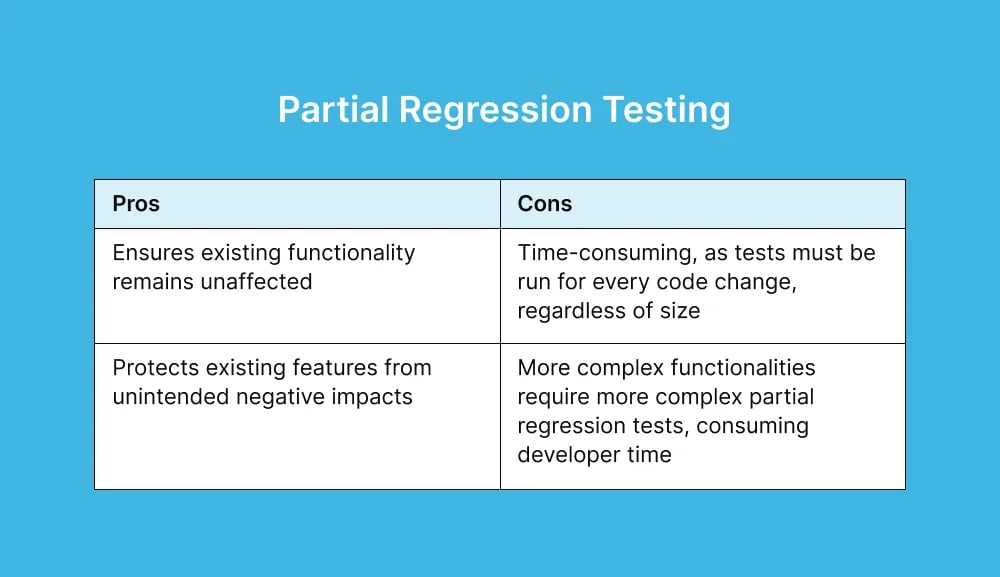
7. Unit regression testing
Conducted in isolation, primarily focusing on code units without dependencies or interactions.
A unit can encompass a single line of code, function, class, method, procedure, module, or object. These tests offer a granular view of code performance and are particularly effective for small-scale evaluations.
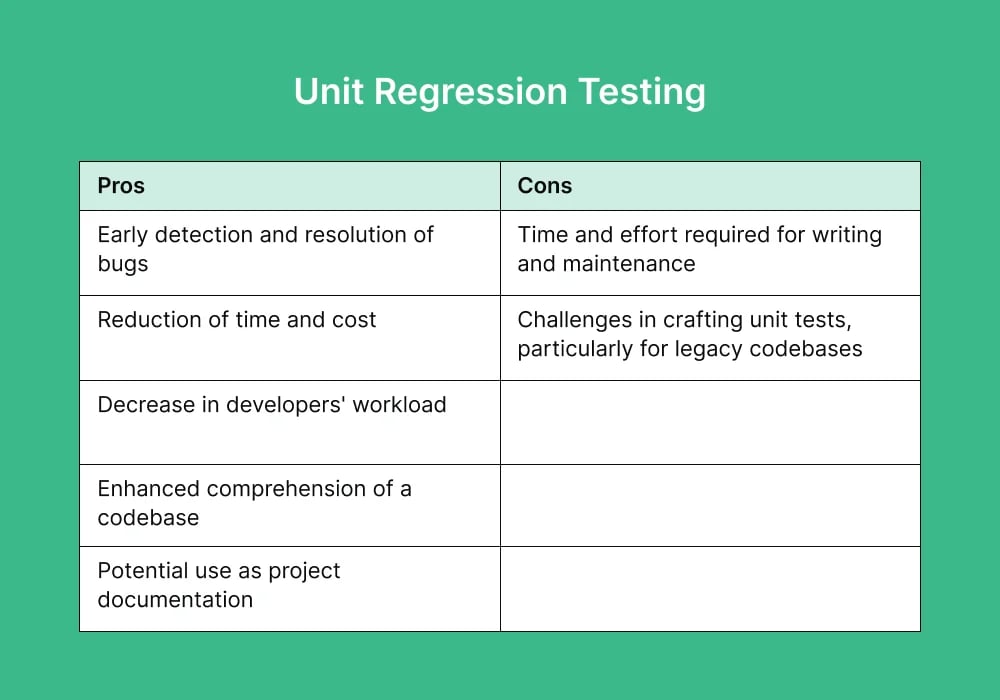
How to prioritize your test cases for a regression test
It is not possible to answer "how much" regression testing you should do and how often (although, as a testing company, we generally argue in favor of a proactive and thorough testing approach).
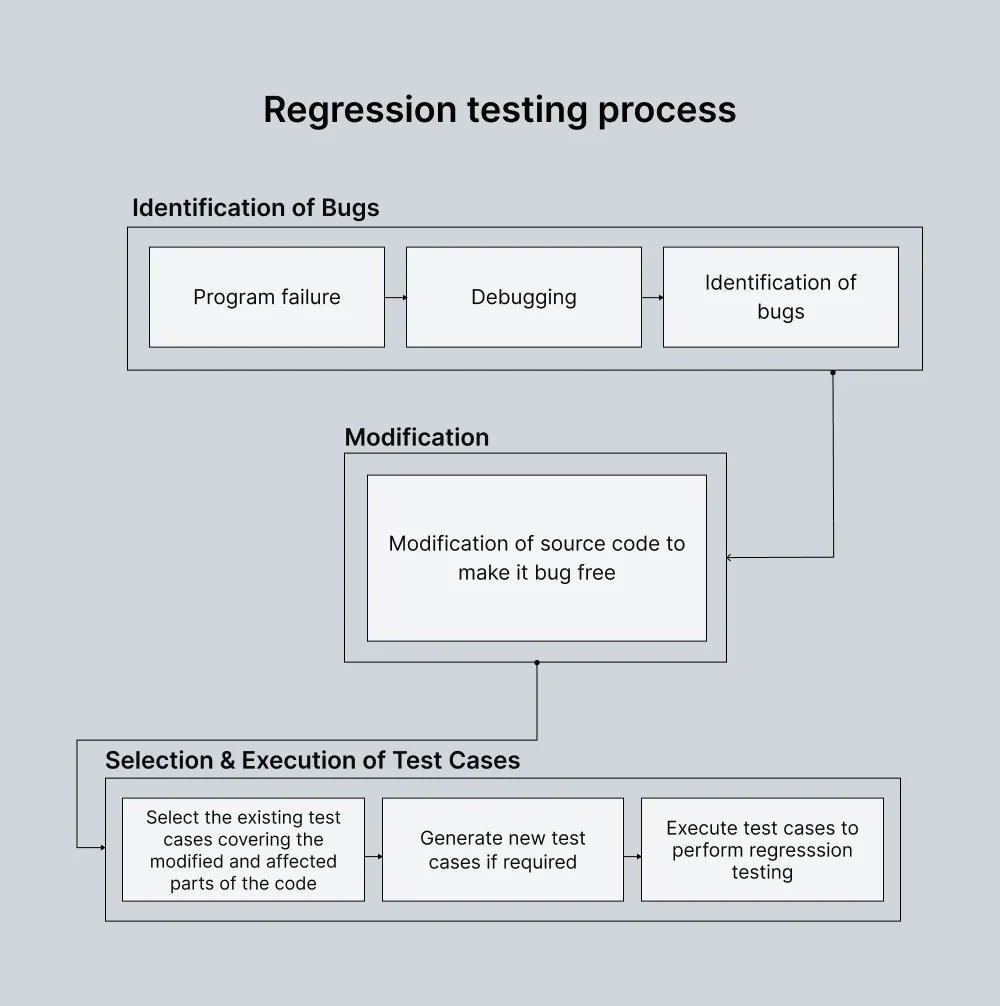
Instead, we'd recommend identifying two or three distinct regression suite tiers and calculating their cost and impact level. Ensure you can calculate both the time and the cash cost of executing each tier of the test suite so that you can refer quickly to your figures at the decision stage. This will enable your business to choose the appropriate depth for the moment and encourage you to track what level of testing you are conducting in general – and whether that aligns with your budget and risk appetite.
What kind of test cases?
In regression testing, businesses often have to choose between retesting all test cases or selecting a subset. While the "retest all" approach involves re-executing every test case, it is time-consuming and costly. Therefore, many businesses opt for a selective approach. Once this decision is made, the challenge becomes determining which test cases to prioritize in the regression suite.
Again, this is often specific to your business and product. However, we've seen our clients prioritize test cases in their regression suites using the following value:
- High vulnerability test cases: Prioritize areas of the product prone to bugs and imperfections.
- Critical test cases: Address the most significant failures from safety, legal, or business perspectives.
- Complex & integration test cases: Include tests where integrations are simultaneously critical to business and prone to failure.
- Relevance to changes: Prioritize test cases relevant to specific changes or releases, such as login system modifications.
- Comprehensive coverage: Select a diverse range of test cases covering various system modules.
- Randomly selected cases: Rotate through test cases to ensure comprehensive system testing over multiple regression suites.
- Some combination of the above: Most frequently, regression test cases reflect multiple priorities. As a compromise between time, risk, and different priorities, regression suites are about judgment.
Automated vs manual regression testing
Regression testing can be done manually or with the help of automated testing tools. Manual involves manually retesting the software after changes have been made. This can be time-consuming and may require a large team of testers.
Automated regression testing, on the other hand, uses software tools to automatically retest the software. This can be faster and more efficient than manual testing. Still, setting up and maintaining the testing tools requires specialized skills and expertise.
Best regression testing tools
There are a large number of regression testing tools available on the market to help you undertake a regression test. For example:
- Global App Testing: GAT's dashboard allows you to send a test to 90,000 testers worldwide with a 6-hour turnaround, perfectly complementing the below automated testing tools.
- Selenium is a popular open-source test automation tool for testing web applications. It supports multiple programming languages and can be used for functional, regression, and performance testing.
- Appium supports both Android and iOS platforms and can be used for functional, regression, and performance testing.
- Apache JMeter is an open-source tool for load testing, functional testing, and regression testing of web applications.
You can learn more about the most suitable tools in our blog post, 10 Regression testing tools to consider.
Test automation challenges
While automation can speed up these processes, there are also some drawbacks:
1. Overestimation of automation:
- Research by TestRail indicates that businesses tend to overestimate their test automation capabilities. Despite forecasting a 30% increase in automated tests, the actual average increase is closer to 1%. This gap highlights not only a failure to automate tests but also a failure to acknowledge the lack of progress.
2. Flaky tests:
- Respondents in a TestRail and Global App Testing webinar identified flaky tests as a significant obstacle to increased automation. The short half-life of automated tests poses challenges, prompting the need for reliable criteria to determine the suitability of automating specific test cases.
3. Time investment cycle:
- The failure to automate tests results in increased manual testing demands, creating a time-consuming cycle for engineers. This cycle perpetuates as less time spent on automation or fixing issues leads to more manual testing, further impeding automation efforts.
Pro tip
Global App Testing is a crowdtesting platform - we send tests to a network of human testers around the world (like "Uber for testing"), and you receive them back in less than 6 or less than 48 hours, depending on the level of specialism.
That means that if you're struggling to automate more of your tests, Global App Testing lets you simulate the speed benefits of automated testing without demanding your engineers do the automation work. In fact, we actively help businesses close their "automation gap."
Why is regression testing crucial in Agile and CI/CD environments?
Regression testing is integral to Agile testing methodologies, where constant iteration, integration, and testing of new code are fundamental. With frequent releases, this testing allows quicker feedback loops and prevents the accumulation of defective code near production dates. In CI/CD pipelines, automated tests form the backbone. These pipelines enable continuous testing alongside the continuous integration of new code. Moreover, they allow for nuanced analysis, identifying optimization opportunities beyond defect detection, such as enhancing user experience (UX).
Still, regression testing extends beyond functionality. Visual regression testing, for instance, detects visual anomalies resulting from code changes. This method is particularly useful when outdated UI elements cause issues like non-clickable buttons or misaligned images across various devices and browsers.
.webp?width=1200&height=947&name=Untitled%20(29).webp)
How to integrate regression testing in Agile environments
Software development teams must balance rapid releases with thorough testing in an Agile or DevOps workflow. Regression testing can become a bottleneck in this process if not appropriately managed. However, there are ways to effectively regression test without slowing down the development process:
- Use automated testing tools to swiftly execute test cases, integrating them into your DevOps pipeline for early issue detection.
- Focus on critical features by prioritizing tests and optimizing time and resources while ensuring thorough coverage.
- Parallel testing speeds up testing processes and executes multiple test cases simultaneously, which is particularly beneficial for large-scale regression testing.
- Implement Continuous testing throughout the development cycle to catch issues early, prevent regression testing bottlenecks, and ensure reliable, bug-free software.
Best practices for regression testing
- Give yourself a buffer day. Regression testing is often time-intensive, and planning around it can be poor. Other items eat into your testing time, and you have less time than you budgeted. That makes it a good idea to have a buffer day, so you can eat into the buffer day rather than release something you're not satisfied with into production.
- Test in an environment that is as close to production as possible. The closer to the production environment you can undertake while still testing early in the process, the better. In particular, the size of the database the test will interact with may have results when it comes to
- Know when to cancel: If you have a two-day regression cycle, after the first four hours, you know there are too many problems for the build to "pass" the test; you'll have to decide whether to complete the test and find all the issues.
- Define the scope: Clearly define the scope of the regression testing process to ensure that all necessary features and functionality are tested.
- Automate whenever possible: Use automated testing tools to speed up the regression testing process and reduce the risk of human error.
- Prioritize test cases: Prioritize test cases based on their criticality and potential impact on the software.
- Use real-world scenarios: Test the software to ensure it meets end-users needs.
- Reuse test cases: Reuse existing test cases to save time and resources.
- Before a big test case, start with a smoke test to prevent additional resources from being wasted.
Common failure categories of regression testing
- Incomplete testing: When not all features or functionality are tested, the regression testing process can be incomplete, leading to potential issues in the software.
- Insufficient test coverage can lead to missed bugs and other issues, which can impact the overall quality of the software.
- Lack of prioritization: Without it, test cases may not be executed in the right order, leading to delays and potential issues in the software.
- Inadequate reporting: Inadequate reporting can lead to a lack of visibility into the testing process and the results, making it difficult to identify issues and track progress.
How can Global App Testing help with regression testing?
At Global App Testing (GAT), we guide teams through the entire testing lifecycle, from initial planning to beta testing and result analysis. Swiftly elevating apps from "good" to "amazing" enhances usability, increases value for stakeholders, and ensures the smooth operation of the development process:
- Intuitive test management: GAT provides an intuitive interface for seamless test creation and management.
- Large tester pool: With over 90,000 professional testers, GAT ensures comprehensive test coverage.
- Rapid execution: Test cases are executed swiftly, with an average turnaround time of 60-150 minutes.
- Continuous testing: The platform allows continuous, on-demand tests, providing 24/7 accessibility.
- Data analysis: GAT simplifies data analysis, converting raw data into user-friendly formats for quick insights.
- Comprehensive reports: We deliver detailed bug reports, including video recordings and screenshots, within 24–36 hours.
- Integrations: GAT enhances workflow efficiency by seamlessly integrating with major project management software, such as Jira, TestRail, Zephyr, and GitHub.
- Security: Following ISO/IEC 27001 standards, GAT ensures enterprise-grade security for testing processes.
Our regression testing is conducted by dedicated QA engineers and testers, ensuring quality assurance and swift results. This allows DevOps teams to focus on other critical aspects, with regression testing tailored to the product's stage or maturity level.
Interested to learn more? Call our QA specialist today to ensure your product is user-friendly and bug-free!
Keep learning
6 iOS testing frameworks to use
Android mobile app testing checklist for testing
6 QA testing methodologies and techniques
FAQ
How is regression testing different from other types of testing?
Regression testing focuses specifically on verifying that existing functionalities remain intact after code changes. In contrast, other types of testing, such as functional or performance testing, examine different aspects of the software's behavior.
What are regression test suites?
Regression test suites are collections of test cases repeatedly executed during regression testing to validate the software's stability. They typically include a combination of high-priority test cases covering critical functionalities.
How do you measure the effectiveness of regression testing?
The effectiveness of regression testing can be measured by tracking metrics such as test coverage, defect detection rate, regression test execution time, and the number of escaped defects found in production. Continuous improvement efforts based on these metrics can help optimize regression testing processes over time.
Need help with QA testing?
We’d love to give you a personal demo of our platform. Find out how we manage, execute and analyse test results to help you release high quality software anywhere in the world.

